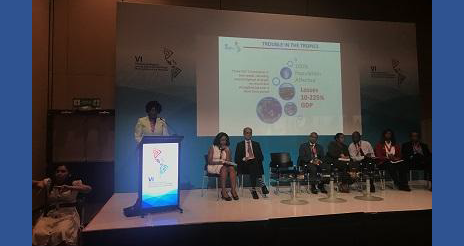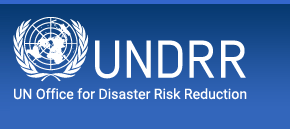- Our Mandate
- Mission and Objectives
- UNDRR in the UN
- Work Programme & Annual Reports
- Results Based System
- Work Partnerships
- Headquarters - Geneva
- SG-UN representatives for DRR
- Regional Office – The Americas and the Caribbean
- Head of the Regional Office – The Americas and the Caribbean
- What is Disaster Risk Reduction?
- What is the International Strategy?
- History of UNDRR
Caribbean rises to resilience challenge
 Andria Grosvenor, Caribbean Disaster Emergency Management Agency, speaking at the Americas Regional Platform on Disaster Risk Reduction
Andria Grosvenor, Caribbean Disaster Emergency Management Agency, speaking at the Americas Regional Platform on Disaster Risk Reduction
By Richard Waddington
Cartagena, Colombia, June 21 – The deadly 2017 hurricanes in the Caribbean posed huge challenges but they also offer opportunities to build better disaster preparedness and response systems, a conference heard.
With the region now bracing for the 2018 season, key lessons that emerged from the havoc wrought by hurricanes Irma and Maria, category 5 storms in 2017, include the need for enhanced response capacity for fast-moving, multiple and catastrophic events, and to tackle environmental and development questions, such as building standards and codes for land use and management.
Resilience-building measures and responses must also take account of the needs of the most vulnerable, including young children and those with disabilities.
"This is a transformational opportunity. True resilience in the Caribbean will require transformation in our economies, our social programmes, in our environmental programmes, in our critical infrastructure, in our risk governance and in key institutions," said Andria Grosvenor, Planning and Business Development Manager, Caribbean Disaster Emergency Management Agency (CDEMA).
She urged the Caribbean to take advantage of the various global development agendas – on sustainable development, climate change and the Sendai Framework on disaster reduction – and leverage them to achieve more sustainable societies. Policies designed to face up to the consequences of climate change could, for example, help strengthen resilience to natural disasters.
Financing remains an important issue, with gaps between what is available and what is needed when it comes to disaster risk management and reduction.
Hurricanes are an important theme at the Vl Regional Platform on Disaster Risk Reduction being held here June 20-22. Some 200 people lost their lives on 12 islands in the Caribbean in those of 2017 and more than one million people were affected. Economic losses exceeded $100 billion, with GDP losses ranging from 10 per cent to 224 per cent in the case of Dominica.
The Climate Risk and Early Warning Systems (CREWS) initiative, supported by the World Meteorological Organization (WMO), the UN Office for Disaster Reduction and the World Bank/ GFDRR (Global Facility for Disaster Reduction and Recovery), will issue a report in Cartagena on lessons learned from the 2017 season.
The report identifies how to enhance the early warning systems and increase preparedness of Caribbean communities for the 2018 season and highlights gender issues and how men and women were affected differently by events.
Despite the devastation, even some of the hardest hit islands have been showing signs of recovery. "It is not a picture of gloom and doom. Visitors are coming back," said Evangeline Innis-Springer, Deputy Director with the Department of Disaster Management, the Virgin Islands. But it is a slow process. "The road to recovery is not a quick fix," she said.
Risk evaluation is fundamental. Preparation needs to be constant because hurricanes are not the only threat; the region is also exposed to other phenomenon, such as earthquakes, heavy rains and landslides.
The private sector should play a role, but research shows that it is little prepared. Only 35 per cent of private companies have any documented disaster resistance plan and of these about 25 per cent are in need of updating or testing, said Jeremy Collymore, Research Fellow, University of the West Indies.
Another issue is the effectiveness of government. "The elephant in the room is that we don't talk about governments. One of the central issues is governance," said Deodat Maharaj, UNDP Senior Advisor for the Caribbean.
The Caribbean's ability to prepare for natural disasters and respond to them effectively is limited by its economic weaknesses – its low economic growth and productivity and its high levels of debt, said Dr. Justin Ram, Director Economics, Caribbean Development Bank (CDB).
A crucial element in recovery from natural disaster is getting people back to work in a region where most people are employed in micro and small enterprises. Better insurance schemes could help in allowing these businesses to get up and running quickly.
But the situation also calls for greater regional integration. "You cannot have a resilient island, we need to have a resilient region," Ram said.
Related links
Sendai Framework for Disaster Risk Reduction
The 6th Regional Platform for Disaster Risk Reduction in the Americas
Follow the UNDRR news online :
 Now we have twitter account @UNDRR Américas y el Caribe
Now we have twitter account @UNDRR Américas y el Caribe
JOIN US!
Tweets por el @UNDRR Américas y el Caribe
